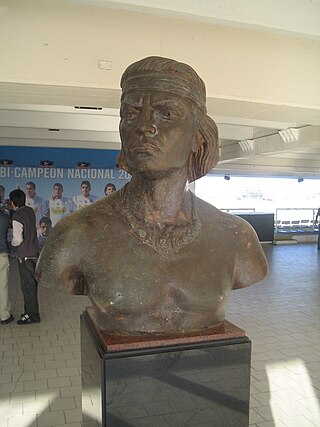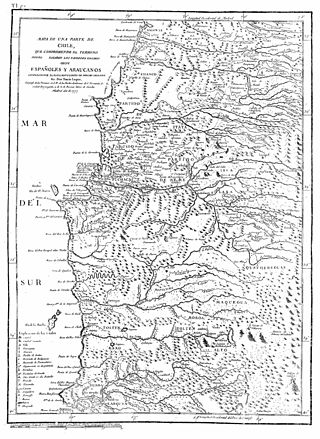Related Research Articles

Colocolo was a Mapuche leader in the early period of the Arauco War. He was a major figure in Alonso de Ercilla y Zúñiga's epic poem La Araucana, about the early Arauco War. In the poem he was the one that proposed the contest between the rival candidates for Toqui that resulted in the choice of Caupolicán. As a historical figure there are some few contemporary details about him. Stories of his life were written long after his lifetime and display many points of dubious historical accuracy.

Caupolicán was a toqui or war leader of the Mapuche people, who led the resistance of his people against the Spanish Conquistadors who invaded the territory of today's Chile during the sixteenth century. His rule as Toqui lasted roughly from 1553-1558 AD.

The Arauco War was a long-running conflict between colonial Spaniards and the Mapuche people, mostly fought in the Araucanía. The conflict began at first as a reaction to the Spanish conquerors attempting to establish cities and force Mapuches into servitude. It subsequently evolved over time into phases comprising drawn-out sieges, slave-hunting expeditions, pillaging raids, punitive expeditions, and renewed Spanish attempts to secure lost territories. Abduction of women and war rape was common on both sides.

Toqui is a title conferred by the Mapuche on those chosen as leaders during times of war. The toqui is chosen in an assembly or parliament (coyag) of the chieftains (loncos) of various clans (Rehues) or confederation of clans (Aillarehues), allied during the war at hand. The toqui commanded strict obedience of all the warriors and their loncos during the war, would organize them into units and appoint leaders over them. This command would continue until the toqui was killed, abdicated (Cayancaru), was deposed in another parliament, or upon completion of the war for which he was chosen.
The Battle of Curalaba is a 1598 battle and ambush where Mapuche people led by Pelantaru soundly defeated Spanish conquerors led by Martín García Óñez de Loyola at Curalaba, southern Chile. In Chilean historiography, where the event is often called the Disaster of Curalaba, the battle marks the end of the Conquest of Chile period in Chile's history, although the fast Spanish expansion in the south had already been halted in the 1550s. The battle contributed to unleash a general Mapuche uprising that resulted in the Destruction of the Seven Cities. This severe crisis reshaped Colonial Chile and forced the Spanish to reassess their mode of warfare.

Pelantaro or Pelantarú was one of the vice toquis of Paillamachu, the toqui or military leader of the Mapuche people during the Mapuche uprising in 1598. Pelantaro and his lieutenants Anganamon and Guaiquimilla were credited with the death of the second Spanish Governor of Chile, Martín García Óñez de Loyola, during the Battle of Curalaba on December 21, 1598.
Illangulién, Quiromanite, Queupulien or Antiguenu, was the Mapuche toqui elected to replace Lemucaguin or Caupolicán the younger in 1559 following the Battle of Quiapo to his death in battle in the Battle of Angol in 1564.
Caupolicán the Younger according to Juan Ignacio Molina was the son of the toqui Caupolicán. He was made toqui following the capture and execution of his father in 1558. He continued the first Mapuche rising against the Spanish conquistadors in 1558 and commanded the Mapuche army in constructing a pukara at Quiapo to block García Hurtado de Mendoza from rebuilding a fort in Arauco completing the chain of forts for suppression of their rebellion. In the Battle of Quiapo the Mapuche suffered a terrible defeat and there Caupolicán the younger died. His successor as toqui was Illangulién.
Cadeguala or Cadiguala was a Mapuche toqui elected in 1585 following the death in battle of the previous toqui Nangoniel. Cadeguala was a noted warrior and the first Mapuche toqui known to have used cavalry successfully in battle. He was killed in a duel with the garrison commander of the Spanish fort at Purén in 1586.
Paineñamcu or Paynenancu or Alonso Diaz, was the Mapuche toqui from 1574 to 1584. Alonso Diaz was a mestizo Spanish soldier offended because the Governor of Chile did not promote him to the officer rank of alféres, who subsequently went over to the Mapuche in 1572. He took the Mapuche name of Paineñamcu and because of his military skills was elected toqui in 1574 following the death of Paillataru.
The Battle of Angol was a battle fought between the Mapuche and the Spanish Empire on 25 March 1564 as part of Arauco War.
Vilumilla was the Mapuche Toqui elected in 1722 to lead the Mapuche Uprising of 1723 against the Spanish for their violation of the peace.
During the siege of Concepcion of the Arauco War, 20,000 warriors of the army of the Mapuche laid siege to the Spanish garrison and civil population in the fortress of Concepcion, Chile.
Loble, also known as Lig-lemu or Lillemu,(d. ca. 1565) was the Mapuche vice-toqui of the Moluche north of the Bio-Bio River who led the second Mapuche revolt during the Arauco War.
Pedro de Avendaño a Spanish soldier that had arrived in Chile with the army of García Hurtado de Mendoza in 1557. He distinguished himself in the Battle of Millarapue. He later served in the garrison of Cañete under captain Alonso de Reinoso. Reinoso eventually found an Indian who betrayed the location of the fugitive Mapuche toqui Caupolicán. Avendaño, with 50 men and the traitorous Indian as a guide, marched in stormy weather into the mountains to Pilmaiquén and captured Caupolicán as he was planning a new counter-offensive against the Spanish, near the modern Antihuala, on February 5, 1558. He brought the toqui back to Cañete where he was eventually executed by impalement at the order of corregidor Reinoso.
Juan Henríquez de Villalobos ; Spanish soldier and administrator who, after participation in various European wars, was designated as governor of Chile by Mariana of Austria. In this position, between October 1670 and April 1682, he became, according to Chilean historiography, the epítome of the corrupt and nepotistic governor. His government tenure was darkened by a long series of litigations and accusations by oidores of the Real Audiencia of Santiago and other vecinos of the colony. He was one of the governors who left the position richer than he began, with not less than 900 thousand pesos, according to Jose Toribio Medina.
The Mapuche were a bellic culture, and their history was plagued by wars and conflicts since they began to settle in the Araucanía; they believed that history was created through warfare, and thus engaged in many military conflicts.
The Parliament of Malloco was held between governor Juan Henríquez de Villalobos and leaders of the Mapuche in January 1671, at Malloco southwest of Santiago, Chile.
Butapichón or Butapichún or Putapichon was the Mapuche toqui from 1625 to 1631, as successor to Lientur. After the death of Quepuantú in 1632 he became toqui once again from 1632 to 1634.
Paillamachu, was the Mapuche toqui from 1592 to 1603 in what is now Chile.
